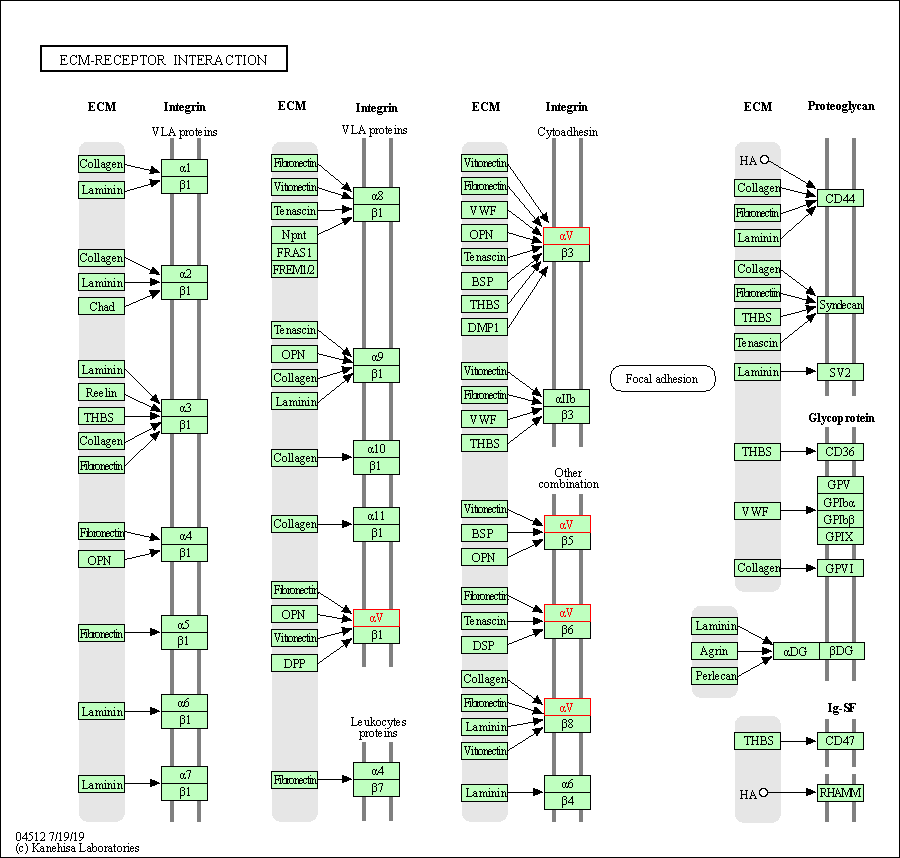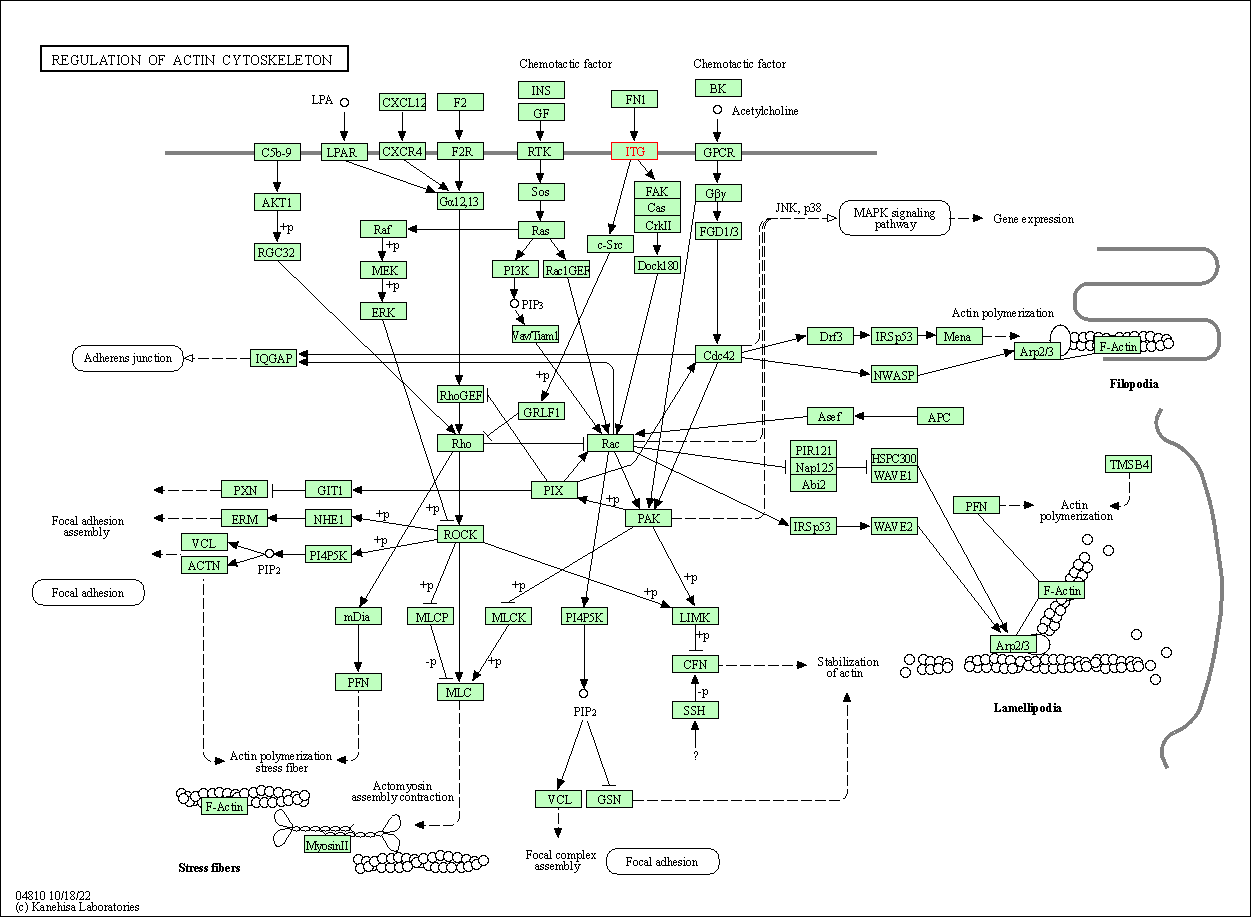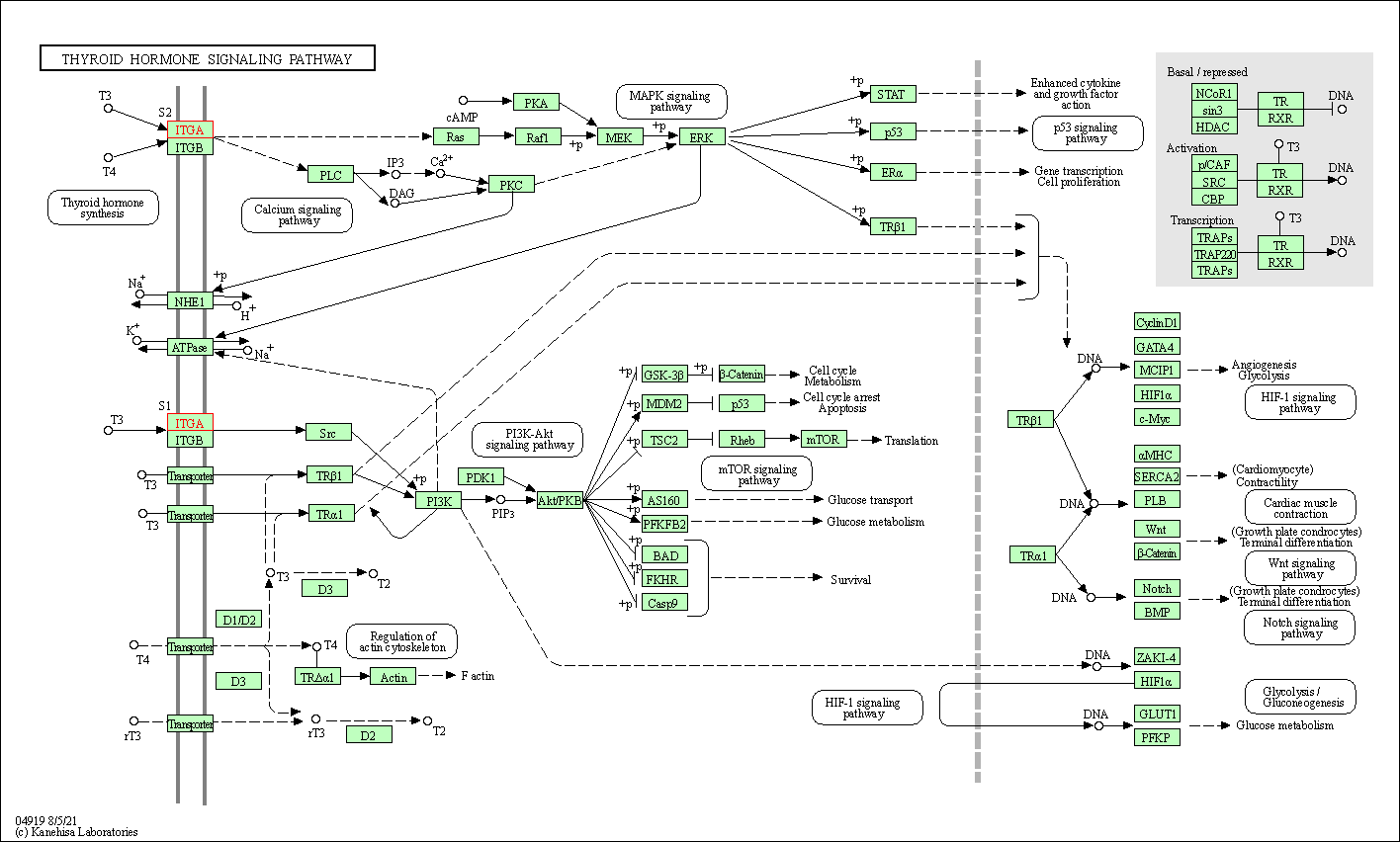Target Information
| Target General Information | Top | |||||
|---|---|---|---|---|---|---|
| Target ID |
T67103
(Former ID: TTDR00473)
|
|||||
| Target Name |
Integrin alpha-V (ITGAV)
|
|||||
| Synonyms |
Vitronectin receptor subunit alpha; Vitronectin receptor alpha subunit; Vitronectin receptor; VTNR; VNRA; MSK8; CD51 antigen; CD51
Click to Show/Hide
|
|||||
| Gene Name |
ITGAV
|
|||||
| Target Type |
Clinical trial target
|
[1] | ||||
| Disease | [+] 2 Target-related Diseases | + | ||||
| 1 | Colorectal cancer [ICD-11: 2B91] | |||||
| 2 | Solid tumour/cancer [ICD-11: 2A00-2F9Z] | |||||
| Function |
The alpha-V (ITGAV) integrins are receptors for vitronectin, cytotactin, fibronectin, fibrinogen, laminin, matrix metalloproteinase-2, osteopontin, osteomodulin, prothrombin, thrombospondin and vWF. They recognize the sequence R-G-D in a wide array of ligands. ITGAV:ITGB3 binds to fractalkine (CX3CL1) and may act as its coreceptor in CX3CR1-dependent fractalkine signaling. ITGAV:ITGB3 binds to NRG1 (via EGF domain) and this binding is essential for NRG1-ERBB signaling. ITGAV:ITGB3 binds to FGF1 and this binding is essential for FGF1 signaling. ITGAV:ITGB3 binds to FGF2 and this binding is essential for FGF2 signaling. ITGAV:ITGB3 binds to IGF1 and this binding is essential for IGF1 signaling. ITGAV:ITGB3 binds to IGF2 and this binding is essential for IGF2 signaling. ITGAV:ITGB3 binds to IL1B and this binding is essential for IL1B signaling. ITGAV:ITGB3 binds to PLA2G2A via a site (site 2) which is distinct from the classical ligand-binding site (site 1) and this induces integrin conformational changes and enhanced ligand binding to site 1. ITGAV:ITGB3 and ITGAV:ITGB6 act as a receptor for fibrillin-1 (FBN1) and mediate R-G-D-dependent cell adhesion to FBN1. Integrin alpha-V/beta-6 or alpha-V/beta-8 (ITGAV:ITGB6 or ITGAV:ITGB8) mediates R-G-D-dependent release of transforming growth factor beta-1 (TGF-beta-1) from regulatory Latency-associated peptide (LAP), thereby playing a key role in TGF-beta-1 activation.
Click to Show/Hide
|
|||||
| BioChemical Class |
Integrin
|
|||||
| UniProt ID | ||||||
| Sequence |
MAFPPRRRLRLGPRGLPLLLSGLLLPLCRAFNLDVDSPAEYSGPEGSYFGFAVDFFVPSA
SSRMFLLVGAPKANTTQPGIVEGGQVLKCDWSSTRRCQPIEFDATGNRDYAKDDPLEFKS HQWFGASVRSKQDKILACAPLYHWRTEMKQEREPVGTCFLQDGTKTVEYAPCRSQDIDAD GQGFCQGGFSIDFTKADRVLLGGPGSFYWQGQLISDQVAEIVSKYDPNVYSIKYNNQLAT RTAQAIFDDSYLGYSVAVGDFNGDGIDDFVSGVPRAARTLGMVYIYDGKNMSSLYNFTGE QMAAYFGFSVAATDINGDDYADVFIGAPLFMDRGSDGKLQEVGQVSVSLQRASGDFQTTK LNGFEVFARFGSAIAPLGDLDQDGFNDIAIAAPYGGEDKKGIVYIFNGRSTGLNAVPSQI LEGQWAARSMPPSFGYSMKGATDIDKNGYPDLIVGAFGVDRAILYRARPVITVNAGLEVY PSILNQDNKTCSLPGTALKVSCFNVRFCLKADGKGVLPRKLNFQVELLLDKLKQKGAIRR ALFLYSRSPSHSKNMTISRGGLMQCEELIAYLRDESEFRDKLTPITIFMEYRLDYRTAAD TTGLQPILNQFTPANISRQAHILLDCGEDNVCKPKLEVSVDSDQKKIYIGDDNPLTLIVK AQNQGEGAYEAELIVSIPLQADFIGVVRNNEALARLSCAFKTENQTRQVVCDLGNPMKAG TQLLAGLRFSVHQQSEMDTSVKFDLQIQSSNLFDKVSPVVSHKVDLAVLAAVEIRGVSSP DHVFLPIPNWEHKENPETEEDVGPVVQHIYELRNNGPSSFSKAMLHLQWPYKYNNNTLLY ILHYDIDGPMNCTSDMEINPLRIKISSLQTTEKNDTVAGQGERDHLITKRDLALSEGDIH TLGCGVAQCLKIVCQVGRLDRGKSAILYVKSLLWTETFMNKENQNHSYSLKSSASFNVIE FPYKNLPIEDITNSTLVTTNVTWGIQPAPMPVPVWVIILAVLAGLLLLAVLVFVMYRMGF FKRVRPPQEEQEREQLQPHENGEGNSET Click to Show/Hide
|
|||||
| 3D Structure | Click to Show 3D Structure of This Target | PDB | ||||
| ADReCS ID | BADD_A00924 | |||||
| HIT2.0 ID | T01QB9 | |||||
| Drugs and Modes of Action | Top | |||||
|---|---|---|---|---|---|---|
| Clinical Trial Drug(s) | [+] 2 Clinical Trial Drugs | + | ||||
| 1 | Abituzumab | Drug Info | Phase 2 | Colorectal cancer | [1] | |
| 2 | IMGN-388 | Drug Info | Phase 1 | Solid tumour/cancer | [2] | |
| Mode of Action | [+] 1 Modes of Action | + | ||||
| Inhibitor | [+] 48 Inhibitor drugs | + | ||||
| 1 | SB-223245 | Drug Info | [4] | |||
| 2 | Ac-Asp-Arg-Leu-Asp-Ser-OH | Drug Info | [5] | |||
| 3 | C(-GRGDfL-) | Drug Info | [6] | |||
| 4 | C(Arg-Gly-Asp-D-Phe-Val) | Drug Info | [7] | |||
| 5 | C(RGDfF) | Drug Info | [8] | |||
| 6 | C(RGDfMeF) | Drug Info | [8] | |||
| 7 | C-[-Arg-Gly-Asp-Acpca30-] | Drug Info | [9] | |||
| 8 | C-[-Arg-Gly-Asp-Acpca31-] | Drug Info | [9] | |||
| 9 | C-[-Arg-Gly-Asp-Acpca32-] | Drug Info | [9] | |||
| 10 | Cyclo(RGDfV) (control) | Drug Info | [10] | |||
| 11 | Cyclo-[-Arg-Gly-Asp-Amp21-] | Drug Info | [11] | |||
| 12 | Cyclo-[-Arg-Gly-Asp-Amp22-] | Drug Info | [11] | |||
| 13 | Cyclo-[-Arg-Gly-Asp-Amp24-] | Drug Info | [11] | |||
| 14 | Cyclo-[-Arg-Gly-Asp-Amp25-] | Drug Info | [11] | |||
| 15 | Cyclo-[-Arg-Gly-Asp-Amp26-] | Drug Info | [11] | |||
| 16 | Cyclo-[-Arg-Gly-Asp-Amp27-] | Drug Info | [11] | |||
| 17 | Cyclo-[-Arg-Gly-Asp-Amp28-] | Drug Info | [11] | |||
| 18 | CYCLORGDFV | Drug Info | [12] | |||
| 19 | Cyclo[RGDfK(cypate)] | Drug Info | [10] | |||
| 20 | Cypate-[(RGD)2-NH2]1 | Drug Info | [10] | |||
| 21 | Cypate-[(RGD)2-NH2]2 | Drug Info | [10] | |||
| 22 | Cypate-[(RGD)3-NH2]1 | Drug Info | [10] | |||
| 23 | Cypate-[(RGD)4-NH2]2 | Drug Info | [10] | |||
| 24 | C[-Arg-Gly-Asp-Acpca19-] | Drug Info | [9] | |||
| 25 | C[-Arg-Gly-Asp-Acpca21-] | Drug Info | [9] | |||
| 26 | C[-Arg-Gly-Asp-Acpca22-] | Drug Info | [9] | |||
| 27 | C[-Arg-Gly-Asp-Acpca34-] | Drug Info | [9] | |||
| 28 | C[-Arg-Gly-Asp-Acpca35-] | Drug Info | [9] | |||
| 29 | C[-Arg-Gly-Asp-Acpca36-] | Drug Info | [9] | |||
| 30 | C[RGDf-(3R)-Carboxymorpholine] | Drug Info | [13] | |||
| 31 | C[RGDf-(3S)-Carboxymorpholine] | Drug Info | [13] | |||
| 32 | C[RGDf-(R)-alpha-TfmF] | Drug Info | [8] | |||
| 33 | C[RGDf-(R)-alpha-TfmV] | Drug Info | [8] | |||
| 34 | C[RGDf-(R)-N-Me-alpha-TfmF] | Drug Info | [8] | |||
| 35 | C[RGDf-(S)-alpha-TfmF] | Drug Info | [8] | |||
| 36 | C[RGDf-(S)-alpha-TfmV] | Drug Info | [8] | |||
| 37 | C[RGDf-(S)-N-Me-alpha-TfmF] | Drug Info | [8] | |||
| 38 | E[c(RGDyK)]2 | Drug Info | [14] | |||
| 39 | E[c(RGDyK)]2-PTX conjugate | Drug Info | [14] | |||
| 40 | G(D-Pen)-G-H-R-G-D-L-R-C-A | Drug Info | [15] | |||
| 41 | Gly-Arg-Gly-Asp-Ser | Drug Info | [16] | |||
| 42 | Gly-Arg-Gly-Asp-Ser-Pro-Lys | Drug Info | [17] | |||
| 43 | ISONIPECOTAMIDE | Drug Info | [18] | |||
| 44 | N-(3,5-dichlorophenyl)imidodicarbonimidic diamide | Drug Info | [19] | |||
| 45 | NAVPNLRGDLQVLAQKVART | Drug Info | [20] | |||
| 46 | RGDechi | Drug Info | [7] | |||
| 47 | SB-265123 | Drug Info | [21] | |||
| 48 | ST-1646 | Drug Info | [11] | |||
| Cell-based Target Expression Variations | Top | |||||
|---|---|---|---|---|---|---|
| Cell-based Target Expression Variations | ||||||
| Drug Binding Sites of Target | Top | |||||
|---|---|---|---|---|---|---|
| Ligand Name: (2S)-2-(1,3-benzothiazole-2-carbonylamino)-4-[5-(1,8-naphthyridin-2-yl)pentanoylamino]butanoic acid | Ligand Info | |||||
| Structure Description | Integrin AlphaVBeta3 ectodomain bound to antagonist TDI-4161 | PDB:6MK0 | ||||
| Method | X-ray diffraction | Resolution | 3.00 Å | Mutation | No | [22] |
| PDB Sequence |
FNLDVDSPAE
10 YSGPEGSYFG20 FAVDFFVPSA30 SSRMFLLVGA40 PKANTTQPGI50 VEGGQVLKCD 60 WSSTRRCQPI70 EFDATGNRDY80 AKDDPLEFKS90 HQWFGASVRS100 KQDKILACAP 110 LYHWRTEMKQ120 EREPVGTCFL130 QDGTKTVEYA140 PCRSQDIDAD150 GQGFCQGGFS 160 IDFTKADRVL170 LGGPGSFYWQ180 GQLISDQVAE190 IVSKYDPNVY200 SIKYNNQLAT 210 RTAQAIFDDS220 YLGYSVAVGD230 FNGDGIDDFV240 SGVPRAARTL250 GMVYIYDGKN 260 MSSLYNFTGE270 QMAAYFGFSV280 AATDINGDDY290 ADVFIGAPLF300 MDRGSDGKLQ 310 EVGQVSVSLQ320 RASGDFQTTK330 LNGFEVFARF340 GSAIAPLGDL350 DQDGFNDIAI 360 AAPYGGEDKK370 GIVYIFNGRS380 TGLNAVPSQI390 LEGQWAARSM400 PPSFGYSMKG 410 ATDIDKNGYP420 DLIVGAFGVD430 RAILYRARPV440 ITVNAGLEVY450 PSILNQDNKT 460 CSLPGTALKV470 SCFNVRFCLK480 ADGKGVLPRK490 LNFQVELLLD500 KLKQKGAIRR 510 ALFLYSRSPS520 HSKNMTISRG530 GLMQCEELIA540 YLRDESEFRD550 KLTPITIFME 560 YRLDYRTAAD570 TTGLQPILNQ580 FTPANISRQA590 HILLDCGEDN600 VCKPKLEVSV 610 DSDQKKIYIG620 DDNPLTLIVK630 AQNQGEGAYE640 AELIVSIPLQ650 ADFIGVVRNN 660 EALARLSCAF670 KTENQTRQVV680 CDLGNPMKAG690 TQLLAGLRFS700 VHQQSEMDTS 710 VKFDLQIQSS720 NLFDKVSPVV730 SHKVDLAVLA740 AVEIRGVSSP750 DHVFLPIPNW 760 EHKENPETEE770 DVGPVVQHIY780 ELRNNGPSSF790 SKAMLHLQWP800 YKYNNNTLLY 810 ILHYDIDGPM820 NCTSDMEINP830 LRIKIHTLGC874 GVAQCLKIVC884 QVGRLDRGKS 894 AILYVKSLLW904 TETFMNKENQ914 NHSYSLKSSA924 SFNVIEFPYK934 NLPIEDITNS 944 TLVTTNVTWG954
|
|||||
|
|
||||||
| Click to View More Binding Site Information of This Target with Different Ligands | ||||||
| Different Human System Profiles of Target | Top |
|---|---|
|
Human Similarity Proteins
of target is determined by comparing the sequence similarity of all human proteins with the target based on BLAST. The similarity proteins for a target are defined as the proteins with E-value < 0.005 and outside the protein families of the target.
A target that has fewer human similarity proteins outside its family is commonly regarded to possess a greater capacity to avoid undesired interactions and thus increase the possibility of finding successful drugs
(Brief Bioinform, 21: 649-662, 2020).
Human Tissue Distribution
of target is determined from a proteomics study that quantified more than 12,000 genes across 32 normal human tissues. Tissue Specificity (TS) score was used to define the enrichment of target across tissues.
The distribution of targets among different tissues or organs need to be taken into consideration when assessing the target druggability, as it is generally accepted that the wider the target distribution, the greater the concern over potential adverse effects
(Nat Rev Drug Discov, 20: 64-81, 2021).
Human Pathway Affiliation
of target is determined by the life-essential pathways provided on KEGG database. The target-affiliated pathways were defined based on the following two criteria (a) the pathways of the studied target should be life-essential for both healthy individuals and patients, and (b) the studied target should occupy an upstream position in the pathways and therefore had the ability to regulate biological function.
Targets involved in a fewer pathways have greater likelihood to be successfully developed, while those associated with more human pathways increase the chance of undesirable interferences with other human processes
(Pharmacol Rev, 58: 259-279, 2006).
Biological Network Descriptors
of target is determined based on a human protein-protein interactions (PPI) network consisting of 9,309 proteins and 52,713 PPIs, which were with a high confidence score of ≥ 0.95 collected from STRING database.
The network properties of targets based on protein-protein interactions (PPIs) have been widely adopted for the assessment of target’s druggability. Proteins with high node degree tend to have a high impact on network function through multiple interactions, while proteins with high betweenness centrality are regarded to be central for communication in interaction networks and regulate the flow of signaling information
(Front Pharmacol, 9, 1245, 2018;
Curr Opin Struct Biol. 44:134-142, 2017).
Human Similarity Proteins
Human Tissue Distribution
Human Pathway Affiliation
Biological Network Descriptors
|
|
|
There is no similarity protein (E value < 0.005) for this target
|
|
Note:
If a protein has TS (tissue specficity) scores at least in one tissue >= 2.5, this protein is called tissue-enriched (including tissue-enriched-but-not-specific and tissue-specific). In the plots, the vertical lines are at thresholds 2.5 and 4.
|
| KEGG Pathway | Pathway ID | Affiliated Target | Pathway Map |
|---|---|---|---|
| Phagosome | hsa04145 | Affiliated Target |

|
| Class: Cellular Processes => Transport and catabolism | Pathway Hierarchy | ||
| PI3K-Akt signaling pathway | hsa04151 | Affiliated Target |

|
| Class: Environmental Information Processing => Signal transduction | Pathway Hierarchy | ||
| Focal adhesion | hsa04510 | Affiliated Target |

|
| Class: Cellular Processes => Cellular community - eukaryotes | Pathway Hierarchy | ||
| ECM-receptor interaction | hsa04512 | Affiliated Target |

|
| Class: Environmental Information Processing => Signaling molecules and interaction | Pathway Hierarchy | ||
| Cell adhesion molecules | hsa04514 | Affiliated Target |

|
| Class: Environmental Information Processing => Signaling molecules and interaction | Pathway Hierarchy | ||
| Regulation of actin cytoskeleton | hsa04810 | Affiliated Target |

|
| Class: Cellular Processes => Cell motility | Pathway Hierarchy | ||
| Thyroid hormone signaling pathway | hsa04919 | Affiliated Target |

|
| Class: Organismal Systems => Endocrine system | Pathway Hierarchy | ||
| Click to Show/Hide the Information of Affiliated Human Pathways | |||
| Degree | 25 | Degree centrality | 2.69E-03 | Betweenness centrality | 6.05E-04 |
|---|---|---|---|---|---|
| Closeness centrality | 2.37E-01 | Radiality | 1.42E+01 | Clustering coefficient | 1.67E-01 |
| Neighborhood connectivity | 3.12E+01 | Topological coefficient | 7.97E-02 | Eccentricity | 11 |
| Download | Click to Download the Full PPI Network of This Target | ||||
| Chemical Structure based Activity Landscape of Target | Top |
|---|---|
| Drug Property Profile of Target | Top | |
|---|---|---|
| (1) Molecular Weight (mw) based Drug Clustering | (2) Octanol/Water Partition Coefficient (xlogp) based Drug Clustering | |
|
|
||
| (3) Hydrogen Bond Donor Count (hbonddonor) based Drug Clustering | (4) Hydrogen Bond Acceptor Count (hbondacc) based Drug Clustering | |
|
|
||
| (5) Rotatable Bond Count (rotbonds) based Drug Clustering | (6) Topological Polar Surface Area (polararea) based Drug Clustering | |
|
|
||
| "RO5" indicates the cutoff set by lipinski's rule of five; "D123AB" colored in GREEN denotes the no violation of any cutoff in lipinski's rule of five; "D123AB" colored in PURPLE refers to the violation of only one cutoff in lipinski's rule of five; "D123AB" colored in BLACK represents the violation of more than one cutoffs in lipinski's rule of five | ||
| Target Poor or Non Binders | Top | |||||
|---|---|---|---|---|---|---|
| Target Poor or Non Binders | ||||||
| Target Regulators | Top | |||||
|---|---|---|---|---|---|---|
| Target-regulating microRNAs | ||||||
| Target-interacting Proteins | ||||||
| Target Profiles in Patients | Top | |||||
|---|---|---|---|---|---|---|
| Target Expression Profile (TEP) | ||||||
| Target-Related Models and Studies | Top | |||||
|---|---|---|---|---|---|---|
| Target Validation | ||||||
| References | Top | |||||
|---|---|---|---|---|---|---|
| REF 1 | Abituzumab combined with cetuximab plus irinotecan versus cetuximab plus irinotecan alone for patients with KRAS wild-type metastatic colorectal cancer: the randomised phase I/II POSEIDON trial. Ann Oncol. 2015 Jan;26(1):132-40. | |||||
| REF 2 | ClinicalTrials.gov (NCT00721669) A Phase I Dose-Escalation Study of IMGN388 in Patients With Solid Tumors. U.S. National Institutes of Health. | |||||
| REF 3 | Anti-alphav integrin monoclonal antibody intetumumab enhances the efficacy of radiation therapy and reduces metastasis of human cancer xenografts in nude rats. Cancer Res. 2010 Oct 1;70(19):7591-9. | |||||
| REF 4 | Discovery of an imidazopyridine-containing 1,4-benzodiazepine nonpeptide vitronectin receptor (alpha v beta 3) antagonist with efficacy in a resten... Bioorg Med Chem Lett. 1998 Nov 17;8(22):3171-6. | |||||
| REF 5 | Synthesis and biological evaluation of non-peptide alpha(v)beta(3)/alpha(5)beta(1) integrin dual antagonists containing 5,6-dihydropyridin-2-one sc... Bioorg Med Chem. 2007 Dec 1;15(23):7380-90. | |||||
| REF 6 | Multiple N-methylation by a designed approach enhances receptor selectivity. J Med Chem. 2007 Nov 29;50(24):5878-81. | |||||
| REF 7 | Novel and selective alpha(v)beta3 receptor peptide antagonist: design, synthesis, and biological behavior. J Med Chem. 2006 Jun 1;49(11):3416-20. | |||||
| REF 8 | Incorporation of the unusual C(alpha)-fluoroalkylamino acids into cyclopeptides: synthesis of arginine-glycine-aspartate (RGD) analogues and study ... J Med Chem. 2006 Mar 9;49(5):1808-17. | |||||
| REF 9 | Grafting aminocyclopentane carboxylic acids onto the RGD tripeptide sequence generates low nanomolar alphaVbeta3/alphaVbeta5 integrin dual binders. J Med Chem. 2005 Dec 1;48(24):7675-87. | |||||
| REF 10 | Design, synthesis, and evaluation of near infrared fluorescent multimeric RGD peptides for targeting tumors. J Med Chem. 2006 Apr 6;49(7):2268-75. | |||||
| REF 11 | Discovery of subnanomolar arginine-glycine-aspartate-based alphaVbeta3/alphaVbeta5 integrin binders embedding 4-aminoproline residues. J Med Chem. 2008 Mar 27;51(6):1771-82. | |||||
| REF 12 | Antiangiogenic effect of dual/selective alpha(5)beta(1)/alpha(v)beta(3) integrin antagonists designed on partially modified retro-inverso cyclotetr... J Med Chem. 2010 Jan 14;53(1):106-18. | |||||
| REF 13 | Morpholine-based RGD-cyclopentapeptides as alphavbeta3/alphavbeta5 integrin ligands: role of configuration towards receptor binding affinity. Bioorg Med Chem. 2009 Feb 15;17(4):1542-9. | |||||
| REF 14 | Synthesis and biological evaluation of dimeric RGD peptide-paclitaxel conjugate as a model for integrin-targeted drug delivery. J Med Chem. 2005 Feb 24;48(4):1098-106. | |||||
| REF 15 | Design and synthesis of novel cyclic RGD-containing peptides as highly potent and selective integrin alpha IIb beta 3 antagonists. J Med Chem. 1994 Jan 7;37(1):1-8. | |||||
| REF 16 | alphavbeta3 Integrin-targeting Arg-Gly-Asp (RGD) peptidomimetics containing oligoethylene glycol (OEG) spacers. J Med Chem. 2009 Nov 26;52(22):7029-43. | |||||
| REF 17 | N-Methylated cyclic RGD peptides as highly active and selective alpha(V)beta(3) integrin antagonists. J Med Chem. 1999 Aug 12;42(16):3033-40. | |||||
| REF 18 | Piperidine-containing beta-arylpropionic acids as potent antagonists of alphavbeta3/alphavbeta5 integrins. Bioorg Med Chem Lett. 2004 Oct 18;14(20):5227-32. | |||||
| REF 19 | Emerging targets in osteoporosis disease modification. J Med Chem. 2010 Jun 10;53(11):4332-53. | |||||
| REF 20 | Structure-function analysis of Arg-Gly-Asp helix motifs in alpha v beta 6 integrin ligands. J Biol Chem. 2007 Mar 30;282(13):9657-65. | |||||
| REF 21 | 1,2,3,4-Tetrahydroquinoline-containing alphaVbeta3 integrin antagonists with enhanced oral bioavailability. Bioorg Med Chem Lett. 2004 Dec 6;14(23):5937-41. | |||||
| REF 22 | Novel Pure alphaVbeta3 Integrin Antagonists That Do Not Induce Receptor Extension, Prime the Receptor, or Enhance Angiogenesis at Low Concentrations. doi:10.1021/acsptsci.9b00041. | |||||
If You Find Any Error in Data or Bug in Web Service, Please Kindly Report It to Dr. Zhou and Dr. Zhang.

